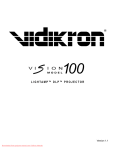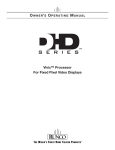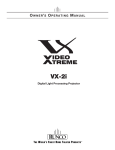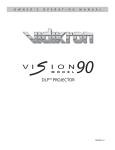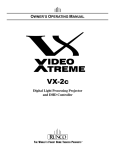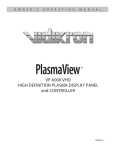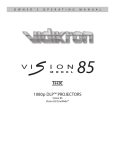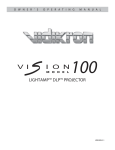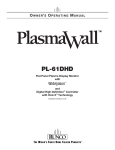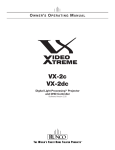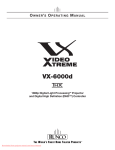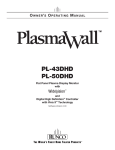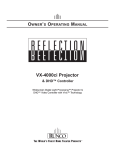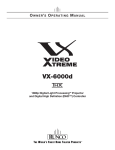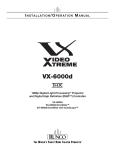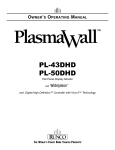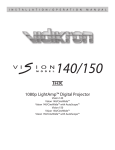Download User Manual - Projector Central
Transcript
L I G H TA M P ™ D L P ™ P R O J E C T O R Version 1.1 TABLE OF CONTENTS Introduction ......................................................................................................................... 2 Warnings & Safety Precautions ......................................................................................... 3 Two Year Limited Warranty .............................................................................................. 5 Projector Rear Panel Description ...................................................................................... 7 Remote Control Description .............................................................................................. 9 Quick Connection and Setup Guide................................................................................... 11 How to Install or Remove the Projector Lamp ................................................................. 13 Lens Shift Range ................................................................................................................. 15 Example of Horizontal and Vertical Lens Shift ................................................................ 17 Menu Description and Navigation ..................................................................................... 18 Opening Screen................................................................................................................. 18 Input Source ...................................................................................................................... 18 Aspect Ratio ...................................................................................................................... 19 Picture ............................................................................................................................... 19 Input Position .................................................................................................................... 21 ISF Presets ........................................................................................................................ 21 Information ....................................................................................................................... 21 Basic Troubleshooting Tips ................................................................................................. 22 RS-232 Communications ..................................................................................................... 23 RS-232 Commands .............................................................................................................. 24 Dimensions............................................................................................................................ 26 Specifications ....................................................................................................................... 27 1 INTRODUCTION » Introduction to the Vidikron Vision Model 100 LIGHTAMP™ DLP™ Projector Vidikron’s new flagship Vision™ Model 100 has been specifically engineered to produce high performance video in the kinds of environments most people use to enjoy their entertainment - family rooms, great rooms and living rooms. Most high-end video projectors are intended for use in dedicated home theater environments with controlled lighting. However, many people prefer to have their entertainment systems in the rooms they use for everyday living. Vidikron has responded by creating the Model 100. The Model 100 has been specially designed to produce very high quality, high resolution pictures even in rooms with plenty of light. The result is a plasma-like picture on a very large screen, even in daylight, with drapes open and lights ablaze! Vidikron has accomplished this by incorporating the most advanced 3-chip, high definition DLP™ technology. This technology is integrated into a specially designed LightAmp™ engine developed by Vidikron engineers to provide the perfect blend of high quality image reproduction and extremely high light output. As a result, the Model 100 produces an amazing 3500 ANSI lumens of light output (CSMS™ Light Output of 78.5 ft-Lamberts). The Model 100’s 16:9 native aspect ratio DMD™ array makes it ideal for widescreen viewing, while its 3-chip, 1280 x 720 native resolution produces crisp, crystal clear high definition images with richly saturated colors, deep black levels and natural, highly refined detail. Vidikron’s exclusive all-digital Imagix™ video processing is integrated into the projector chassis for the most advanced video scaling and image quality available. This advanced design provides pure digital connections from input to light engine for absolutely stellar pictures. In addition, Vidikron’s multiple aspect ratio control includes its unique IntelliWide™ mode for viewing standard video formats in widescreen without loss of image quality. Discrete IR and RS-232 control, and lens shift capability make custom installation seamless, while discrete source and aspect ratio selection accommodate any automation control system. The Vision Model 100 is finished to blend seamlessly with any decor. » The features you’ll enjoy include: • Native Resolution: 1280 x 720 (16:9 Native Aspect Ratio) • 3-chip, HD-2+, Digital Light Processing (DLP™) system • DVI Input with HDCP • HDTV Ready • Multiple Lens Options for Throw Distance Flexibility » Contents of the package: • 3-Chip Projection System • (1) AC Power cord • (1) Remote control with (2) AAA batteries • (1) User’s manual • (1) Warranty information and registration card » Options: • Ceiling mount unit • Tilt mount unit 2 WARNINGS & SAFETY PRECAUTIONS WARNING FCC Regulations state that any unauthorized changes or modifications to this equipment not expressly approved by the manufacturer could void the user’s authority to operate this equipment. CAUTION: TO PREVENT FIRE OR SHOCK HAZARDS, DO NOT REMOVE COVER. DO NOT EXPOSE THIS UNIT TO RAIN OR MOISTURE. ALSO DO NOT USE THIS UNIT’S POLARIZED PLUG WITH AN EXTENSION CORD RECEPTACLE OR OTHER OUTLETS, UNLESS THE PRONGS CAN BE FULLY INSERTED. REFRAIN FROM OPENING THE CABINET AS THERE ARE HIGH-VOLTAGE COMPONENTS INSIDE. NO USER-SERVICEABLE PARTS EXCEPT LAMP UNIT. REFER SERVICING TO QUALIFIED SERVICE PERSONNEL. WARNING High brightness light source. Do not stare into the beam of light, or view directly. Be especially careful that children do not stare directly into the beam of light. WARNING The cooling fan in this projector continues to run for about 90 seconds after the projector is turned off. During normal operation, when turning the power off always use the power (OFF) button on the projector or on the remote control. Ensure the cooling fan has stopped before disconnecting the power cord. The power outlet socket should be installed as near to the equipment as possible, and should be easily accessible. DURING NORMAL OPERATION, NEVER TURN THE PROJECTOR OFF BY DISCONNECTING THE POWER CORD. FAILURE TO OBSERVE THIS WILL RESULT IN PREMATURE LAMP FAILURE. PRODUCT DISPOSAL This projector utilizes tin-lead solder, high intensity discharge lamp (HID lamp) containing a small amount of mercury. Disposal of these materials may be regulated due to environmental considerations. For disposal or recycling information, please contact your local authorities or, if you are located in the United States of America, the Electronic Industries Alliance: www.eiae.org. INFORMATION This equipment has been tested and found to comply with the limits for a Class B digital device, pursuant to Part 15 of the FCC Rules. These limits are designed to provide reasonable protection against harmful interference in a residential installation. This equipment generates, uses, and can radiate radio frequency energy and, if not installed and used in accordance with the operation manual, may cause harmful interference to radio communications. However, there is no guarantee that interference will not occur in a particular installation. If this equipment does cause harmful interference to radio or television reception, which can be determined by turning the equipment off and on, the user is encouraged to try to correct the interference by one or more of the following measures: • Reorient or relocate the receiving antenna. • Increase the separation between the equipment and the receiver. • Connect the equipment into an outlet on a circuit different from that to which the receiver is connected. • Consult the dealer or an experienced radio/TV technician for help. 3 WARNINGS & SAFETY PRECAUTIONS DECLARATION OF CONFORMITY VIDIKRON PROJECTOR, MODEL 100 This device complies with Part 15 of the FCC rules. Operation is subject to the following conditions: (1) This device may not cause harmful interference, and (2) this device must accept any interference received, including interference that may cause undesired operation. WARNING Some IC chips in this product include confidential and/or trade secret property belonging to Texas Instruments. Therefore you may not copy, modify, adapt, translate, distribute, reverse engineer, reverse assemble or discompile the contents thereof. INTELLECTUAL PROPERTY RIGHTS ----- IMPORTANT ----READ BEFORE USING THE PRODUCT • Digital Light Processing, DLP, Digital Micromirror Device and DMD are trademarks of Texas Instruments. • Microsoft and Windows are registered trademarks of Microsoft Corporation in the United States and/or other countries. • PC/AT is a registered trademark of International Business Machines Corporation in the United States. • Adobe Acrobat is a trademark of Adobe Systems Incorporated. • Macintosh is a registered trademark of Apple Computer, Inc. in the United States and/or other countries. • All other company or product names are trademarks or registered trademarks of their respective companies. SAFETY TIPS Please read and follow the safety precautions listed below to ensure the equipment is free from damage, and to ensure that no injury will occur as a result of improper use. · Do not insert any object, especially metal or liquids, into the Projector. · Do not place any objects containing water or any other liquid on top of the Projector. · Do not place the units in direct sunlight, near heaters or in extremely dusty or humid locations. · Do not install this system outdoors or otherwise exposed to the elements. · Do not place heavy objects on top of the Projector. · If the power cord is damaged or frayed in any way, electrical shock and/or fire may result. Please do not place objects on the power cord, and keep the cord away from heat-emitting devices. Should the power cord become damaged in any way, please contact your Vidikron Dealer for a replacement cord. · Do not remove the cover of the Projector for any reason. If any problems arise with the unit, please contact a Vidikron Dealer or Vidikron International for service. Removing the covers will void the warranty. 4 LIMITED WARRANTY TWO YEAR LIMITED WARRANTY For Projectors, Video Processors and Controllers Congratulations on your purchase of a Vidikron video product and welcome to the Vidikron family! With proper installation, setup and care, you should enjoy many years of unparalleled video performance. This is a LIMITED WARRANTY as defined in the Magnuson-Moss Warranty Act. Please read it carefully and retain it with your other important documents. WHAT IS COVERED UNDER THE TERMS OF THIS LIMITED WARRANTY: SERVICE LABOR: Vidikron will pay for service labor by a Vidikron Authorized Service Center when needed as a result of manufacturing defect for a period of two (2) years from the effective date of delivery to the end user (excluding the lamp). PARTS: (Not including the lamp) Vidikron will provide new or rebuilt replacement parts for the parts that fail due to defects in materials or workmanship for a period of two (2) years from the effective date of delivery to the end user. Such replacement parts are then subsequently warranted for the remaining portion (if any) of the original warranty period. PROJECTOR LAMP: Vidikron will pay for service labor by a Vidikron Authorized Service Center when needed as a result of a manufacturing defect for a period of six (6) months or 1000 hours, which ever comes first, from the effective date of delivery to the end user. In addition, Vidikron will provide a new or rebuilt replacement lamp for the lamp that fails due to defects in materials or workmanship for a period of six (6) months or 1000 hours, which ever comes first, from the effective date of delivery to the end user. Such replacement lamps are then subsequently warranted for the remaining portion (if any) of the original warranty period. WHAT IS NOT COVERED UNDER THE TERMS OF THIS LIMITED WARRANTY: This Limited Warranty only covers failure due to defects in materials and workmanship that occur during normal use and does not cover normal maintenance. This Limited Warranty does not cover cabinets or any appearance items; failure resulting from accident, misuse, abuse, neglect, mishandling, misapplication, faulty or improper installation or setup adjustments; improper maintenance, alteration, improper use of any input signal; damage due to lightning or power line surges, spikes and brownouts; damage that occurs during shipping or transit; or damage that is attributed to acts of God. In the case of remote control units, damage resulting from leaking, old, damaged or improper batteries is also excluded from coverage under this Limited Warranty. CAUTION: THIS LIMITED WARRANTY ONLY COVERS VIDIKRON PRODUCTS PURCHASED FROM VIDIKRON AUTHORIZED DEALERS. ALL OTHER PRODUCTS ARE SPECIFICALLY EXCLUDED FROM COVERAGE UNDER THIS LIMITED WARRANTY. MOREOVER, DAMAGE RESULTING DIRECTLY OR INDIRECTLY FROM IMPROPER INSTALLATION OR SETUP IS SPECIFICALLY EXCLUDED FROM COVERAGE UNDER THIS LIMITED WARRANTY. RIGHTS, LIMITS AND EXCLUSIONS: Vidikron limits its obligations under any implied warranties under state laws to a period not to exceed the warranty period. There are no express warranties. Vidikron also excludes any obligation on its part for incidental or consequential damages related to the failure of this product to function properly. Some states do not allow limitations on how long an implied warranty lasts, and some states do not allow the exclusion or limitation of incidental or consequential damages. So the above limitations or exclusions may not apply to you. This warranty gives you specific legal rights, and you may also have other rights that vary from state to state. 5 LIMITED WARRANTY EFFECTIVE WARRANTY DATE: This Limited Warranty begins on the effective date of delivery to the end user. For your convenience, keep the original bill of sale as evidence of the purchase date. IMPORTANT: WARRANTY REGISTRATION: Please fill out and mail your warranty registration card. It is imperative that Vidikron knows how to reach you promptly if we should discover a safety problem or product update for which you must be notified. CONTACT A VIDIKRON AUTHORIZED SERVICE CENTER TO OBTAIN SERVICE: Repairs made under the terms of this Limited Warranty covering your Vidikron video product will be performed at the location of the product, during usual working hours, providing location of product is within normal operating distance from a Vidikron Authorized Service Center. In some instances it may be necessary for the product to be returned to the Vidikron factory for repairs. If, solely in Vidikron’s judgment, location of product to be repaired is beyond normal operating distance of the closest Vidikron Authorized Service Center, or the repair requires the unit be returned to the Vidikron factory, it is the owner’s responsibility to arrange for shipment of the product for repair. These arrangements must be made through the selling Vidikron dealer. If this is not possible, contact Vidikron directly to locate an authorized Vidikron representative who will assist you in getting a return authorization. Vidikron will return product transportation prepaid in the United States, unless no product defect is discovered. In that instance, shipping costs will be the responsibility of the owner. ADDITIONAL INFORMATION: To locate the name and address of the nearest VIDIKRON authorized service location, or for additional information about this Limited Warranty, please call or write: VIDIKRON Attn: Customer Service Department 2900 Faber Street Union City, CA 94587 Ph: (510) 324-5900 Fax: (510) 324-5905 Toll Free: (888) 4-VIDIKRON 6 PROJECTOR REAR PANEL INPUTS 1 2 3 4 5 6 7 8 ����������� ������������������������� LAMP COVER 9 1. 10 11 12 13 14 15 16 17 18 19 DVI 1 (Digital) DVI input #1, HDCP compliant. DVI 2 (Digital) DVI input #2, HDCP compliant. 2. COMPONENT VIDEO (RCA connectors) Standard Definition (480i/576i) Component (YPrPb) input. This is the input for component video from sources such as DVD players. (For best results do not run DVD player in progressive mode). 3. HD 1 (Analog BNC connectors) High Definition input #1, can be RGB(HV) or YPrPb, 480p, 720p, 480i, 576i or 1080i. HD 2 (Analog BNC connectors) High Definition input #1, can be RGB(HV) or YPrPb, 480p, 720p, 480i, 576i or 1080i. 4. COMPOSITE VIDEO (RCA connectors) This is the input for Composite Video input from sources as Laser disc players, VCRs and other miscellaneous video sources. 5. TRIGGERS 1/2/3 (Outputs) Connection for 3 different 12V trigger controlled devices. 6. S-VIDEO 1 INPUT This is the input for S-Video #1 from sources such as Satellite receivers, S-VHS VCR’s and DVD players. S-VIDEO 2 INPUT This is the input for S-Video #2 from sources such as Satellite receivers, S-VHS VCR’s and DVD players. 7 PROJECTOR REAR PANEL INPUTS 7. IR Wired input from an external remote control. 8. RS-232 CONTROL Connection for an external RS-232 controller device to place the Projector under system automation control. 9. VACUUM FLORESCENT DISPLAY Reads out all relevant status information of the Projector at all times. Can be used instead of the On Screen Display. Indicates the model number, current source, scan rate (resolution) and aspect ratio. 10. UP BUTTON Use to direct select aspect ratios or move the menu cursor Up in the On-Screen Display. When no menus are present on-screen, the UP button will toggle you through aspect ratios in the following order: Anamorphic → Standard (4:3) → Letterbox → IntelliWide 11. LEFT BUTTON Used to direct select inputs or move the menu cursor Left in the On Screen Display. When no menu is present onscreen, the LEFT button will toggle you through the different sources, in the order of: HD Pass Thru 2 → HD Pass Thru 1 → DVI 2 → DVI 1 → HD/RGB2 → HD/RGB1 → Component SD → S-Video 2 → S-Video 1 → Composite 12. DOWN BUTTON Use to direct select aspect ratios or move the menu cursor Down in the On-Screen Display. When no menu is present on-screen, this button will toggle you through the different aspect ratios. IntelliWide → Letterbox → Standard (4:3) → Anamorphic 13. ENTER BUTTON When an item is highlighted on the On-Screen Display, the ENTER button will select the item. 14. RIGHT BUTTON Used to direct select inputs or move the menu cursor Right in the On Screen Display.When no menus are present on-screen, the RIGHT button will toggle you through the different sources, in the order of: Composite → S-Video 1 → S-Video 2 → Component SD → HD/RGB 1 → HD/RGB 2 → DVI 1 → DVI 2 → HD Pass Thru 1 → HD Pass Thru 2 15. MENU BUTTON Pressing the MENU button will bring up the main menu. Also, if you are in an adjustment mode or function, pressing MENU will bring the menu back one level. 16. IR RECEIVER Receives the IR commands from the remote. 17. POWER INPUT (100-230v) 18. MAIN POWER SWITCH Disconnects or applies main power to the processor. 19. POWER BUTTON Press once to toggle on from Standby mode to On mode, a second time to place into Standby mode. For a discreet on or off command, you can use the direct access buttons on the remote control. 8 REMOTE CONTROL DESCRIPTION 1. IR OUTPUT INDICATOR Illuminates when a button in pressed, indicating that an IR signal is being transmitted. 2. LIGHT BUTTON Illuminates the remote backlight for improved night visibility. 3. 4. 5. 1 ����� 2 3 �� ��� OFF and ON BUTTON Switches the projector ON and OFF. (These do not operate when POWER/STANDBY indicator of the main unit is off.) CODE BUTTON For Service use only. 4 ���� 5 ��� 6 ��� 8 ��� �� ���� 7 ������ CURSOR (▲ / ▼ / ◄ / ►) Use these buttons to select items or settings and to adjust settings or switch the display patterns. UP Button: When no menus are present on-screen, the UP button will toggle through aspect ratios in the following order: (RATIO) Anamorphic → Standard (4:3) → Letterbox → IntelliWide ��� ��� ���� � 9 10 11 ���������������� 12 13 15 ����� ����� � ���� � � � �� � ����� � ��� � � � � �� � LEFT Button: When no menus are present on-screen, the LEFT button will toggle through the different sources in the following order: (INPUT) HD Pass Thru 2 → HD Pass Thru1 → DVI 2 → DVI 1 → HD/RGB2 → HD/RGB 1 → Component SD → S-Video 2 → S-Video 1 → Composite ���� � � 17 18 20 21 14 16 ��� � ������ � ��� ��� ��� ��� 19 ������ ������ ��� 22 DOWN Button: When no menus are present on-screen, the DOWN button will toggle through the different sources in the following order: (RATIO) IntelliWide → Letterbox → Standard (4:3) → Anamorphic RIGHT Button: When no menus are present on-screen, the RIGHT button will toggle through the different sources in the following order: (INPUT) Composite → S-Video 1 → S-Video 2 → Component SD → HD/RGB 1 → HD/RGB 2 → DVI 1 → DVI 2 → HD Pass Thru 1 → HD Pass Thru 2 6. ENT (ENTER) BUTTON When an item is highlighted on a menu, pressing ENTER will select that item. 7. MENU BUTTON Pressing this button will access the OSD controls. Press this button during the display of the sub-menu to return to the previous menu. 9 REMOTE CONTROL DESCRIPTION MEMORY SETTINGS BUTTONS Four video preset memory setting buttons are available: 8. ISF NT – ISF Night 9. ISF DAY – ISF Day 10. CUST 1 – Custom One 11. CUST 2 – Custom Two SOURCE SELECTION BUTTONS Direct source selection buttons: These will enable direct access to desired inputs, or selection of a number in certain cases. These buttons are: 12. VIDEO BUTTON Press this button to select VIDEO (composite video) as the source. 13. S-VID 1 (S-VIDEO 1) and S-VID 2 (S-VIDEO 2) BUTTONS Press either button to select between S-Video 1 and S-Video 2 inputs. 14. COMP (COMPONENT) BUTTON Press this button to select Component SD (480i/576i) input. 15. HD1 and HD2 BUTTONS Press either button to select between HD1 (High Definition) signal and HD2 signal inputs. Auto detect component input, YPbPr or RGBHV. 16. DVI 1 and DVI 2 BUTTONS Press this button to select between DVI 1 signal and DVI 2 signal input. ASPECT RATIO BUTTONS Aspect ratio selections - these buttons will allow you direct access to a specific aspect ratio: 17. ANA - selects Anamorphic aspect ratio 18. 4x3 - selects Standard 4:3 aspect ratio 19. LETBOX - selects Letterbox aspect ratio 20. I-WIDE - selects IntelliWide aspect ratio 21. CINEMA – selects CinemaScope aspect ratio 22. SVC – selects service menu access 10 QUICK CONNECTION AND SETUP GUIDE While there are many different ways to connect your source equipment to your Vidikron Projector, the examples below are the most common. ANALOG INPUTS: • Composite Video Input Composite video is the most common type of signal used, but is also the lowest in picture quality. Many sources have outputs that are limited to composite video, such as some VCR’s and camcorders; others such as Laser Disc players actually produce slightly better results when using composite video. • S-Video Input S-Video is the second-best type of signal that can be used, but is MUCH better than composite video. Using such sources as Satellite receivers, high-quality VCRs and DVD players (with no component output) will produce a MUCH cleaner and sharper signal. • Component Input Component video is the best type of signal that can be used. The most common sources that use component outputs are DVD players, and it is highly recommended that component be used when possible. Component video goes one step beyond S-Video in picture quality; chroma (color) information is more resolved and the overall picture appears more well-defined. (be sure to shut off progressive scan on your DVD player) • HD1 / HD2 These are High Definition Analog inputs to connect the outputs of high definition sources such as HD tuners and set top boxes, HD satellite receivers, etc. These inputs will accept signals as RGB, RGBHV or Component Video (YPrPb). DIGITAL INPUTS: • DVI 1 / DVI 2 These are High Definition Digital inputs. Vidikron recommends using these digital inputs whenever possible. Using the DVI 1 and DVI 2 inputs ensures the highest video quality because the signal is carried in the digital domain throughout the entire signal path, from source component output into the projector. This maintains maximum signal purity. Use these inputs to connect Digital High Definition sources that have a DVI output, such as HD tuners and set top boxes, satellite receivers, DVD players, etc. ISF Calibration The Vision Model 100 has been designed to incorporate setup and calibration standards established by the Imaging Science Foundation (ISF). The ISF has developed carefully crafted, industry-recognized standards for optimal video performance and has implemented a training program for technicians and installers to use these standards to obtain optimal picture quality from Vidikron video display devices. Accordingly, we recommend that setup and calibration be performed by an ISF certified installation technician. All signal types require separate processing. Therefore there is a need to calibrate each and every input separately. When beginning calibration, it is imperative that at least one of the analog SD inputs (Composite, S-Video, RCA Component) be calibrated first. In doing this, the projector is calibrated to the controller. After one of the SD inputs is calibrated, calibration of the HD analog or DVI sections can follow. Once the initial settings have been completed, the “front panel display” (color, tint, sharpness, etc.) can be adjusted for each aspect ratio. The calibration procedures for these adjustments are outlined in “picture quality adjustments”. 11 QUICK CONNECTION AND SETUP GUIDE Follow the steps below ensure proper installation of the Vision Model 100 projector. NOTE: These steps should be performed by a qualified custom video installation specialist. Step I Connection: 1. Connect Power to the Projector. 2. Connect Video (Composite), S-Video to 1 or 2, Component 480i (RCA) input, HD signals to HD1 or HD2 (BNC), DVI 3. Turn ON the system from the projector control panel and main power switch. Step II 1. Press Menu to select Main window. Select the Service Menu, then Display Device, then the Lens Menu. 2. Adjust Lens shift, Zoom, and Focus for desired screen size and sharpness. 3. Press Menu to go back to the Service Menu, then select Display Device, then the menu for Installation to adjust Picture Orientation. 4. Select for projector mount configuration (Floor Front, Ceiling Front, Floor Rear, or Ceiling Rear) Step III Calibration and Setup: 1. Make sure you have Images on the screen from all connected sources. Note: The system should be setup first by using S-Video or Component 480i (RCA input) preferably Component 480i first. 2. Select Component SD. 3. Using a test disc and select the Pluge pattern for Brightness and 10-step gray scale for Contrast 4. Select Calibration, press Enter and under ISF Night select Input Image. 5. Adjust for correct Brightness and Contrast. 6. Select 80 IRE from test disc. 7. Press Menu to select Main window. Enter the Calibration Menu, select Input Image and press Enter. 8. Select Contrast and press Enter. Under Contrast you have Red, Green, and Blue selection. 9. Use the Up and Down arrow to select Green or Blue and press Enter. The cursor will blink from the selected color. Use the UP or Down arrow to adjust. Press Enter when done to store the number. Note: Decrease the value to set for desired temperature. 10. Select 20 or 30 IRE window for low-end adjustment 11. Select Brightness and adjust RED, Green, or Blue for D6500. Note: Decrease the value to set for D6500. 12. Select color bar from test disc. 13. Select Calibration, press Enter and under ISF Night select Input Image and select Color and press Enter 14. Use the Blue Filter (required) and adjust for correct color setting. 15. For other NTSC sources, select Calibration, press Enter. Under ISF Night, select Input Image and adjust for correct Brightness, Contrast, Color, Tint, and sharpness. Step IV HD and DVI Setup: 1. For HD input and DVI, select Calibration press Enter and under ISF Night select Input Image for video adjustments. 2. Select Input Color for white balance adjustments. 12 HOW TO INSTALL OR REMOVE THE PROJECTOR LAMP IMPORTANT NOTE: LAMP INSTALLATION OR REMOVAL SHOULD ONLY BE PERFORMED BY AN AUTHORIZED VIDIKRON SYSTEM INSTALLER OR TECHNICIAN. Step One: INSURE PROJECTOR AC POWER IS OFF AND POWER CORD IS REMOVED PRIOR TO INSTALLING OR REMVOING THE LAMP ASSEMBLY. Step Two: Loosen the four rear Lamp Cover screws; remove cover: Lamp Cover Screws Step Three: Remove the two lamp assembly mounting screws: Lamp Assembly Screws 13 HOW TO INSTALL OR REMOVE THE PROJECTOR LAMP Next, grasp the lamp assembly handle and pull gently, removing the lamp module out of the projector housing. Lamp Assembly Handle Step Four: Replace lamp module and replace, retighten all screws. Lamp Cover Screws 14 LENS SHIFT RANGE Lens Option 1: Throw Distance 1.2 - 1.4 x Width of Screen When only Vertical or only Horizontal Shift is used: Maximum. Vertical Shift ↑ = 60% of screen height (.60 x height) Maximum. Vertical Shift ↓ = 24% of screen height (.24 x height) Maximum Horizontal Shift = 10% of screen width (.10 x width) Amount of Horizontal Shift when Vertical is @ maximum: Maximum Horizontal Shift < 5% of screen width (.05 x width) Amount of Vertical Shift when Horizontal is @ maximum: Maximum Vertical Shift ↑ < 10% of screen height (.10 x height) Maximum Vertical Shift ↓ < 10% of screen height (.10 x height) 0.05 X 100” = 5.0” left or right 0.10 X 56” = 5.6” up or down When only Vertical or only Horizontal Shift is used: Maximum. Vertical Shift ↑ = 60% of screen height (.60 x height) Maximum. Vertical Shift ↓ = 24% of screen height (.24 x height) Maximum Horizontal Shift = 13% of screen width (.13 x width) Amount of Horizontal Shift when Vertical is @ maximum: Maximum Horizontal Shift < 5% of screen width (.05 x width) Amount of Vertical Shift when Horizontal is @ maximum: Maximum Vertical Shift ↑ < 10% of screen height (.10 x height) Maximum Vertical Shift ↓ < 10% of screen height (.10 x height) Example: 56” x 100” Screen TD = 140” to 177” lens to screen 0.24 X 56” = 13.44” up or down 0.13 X 100” = 13.0” left or right 0.05 X 100” = 5.0” left or right 0.10 X 56” = 5.6” up or down Lens Option 3: Throw Distance 1.77 - 2.35 x Width of Screen When only Vertical or only Horizontal Shift is used: Maximum. Vertical Shift ↑ = 60% of screen height (.60 x height) Maximum. Vertical Shift ↓ = 24% of screen height (.24 x height) Maximum Horizontal Shift = 16% of screen width (.16 x width) Amount of Horizontal Shift when Vertical is @ maximum: Maximum Horizontal Shift < 5% of screen width (.05 x width) Amount of Vertical Shift when Horizontal is @ maximum: Maximum Vertical Shift ↑ < 10% of screen height (.10 x height) Maximum Vertical Shift ↓ < 10% of screen height (.10 x height) Example: 56” x 100” Screen TD = 177” to 235” lens to screen 0.24 X 56” = 13.44” up or down 0.16 X 100” = 16.0” left or right 0.05 X 100” = 5.0” left or right 0.10 X 56” = 5.6” up or down Explanation: • • TD = 120” to 140” lens to screen 0.24 X 56” = 13.44” up or down 0.10 X 100” = 10.0” left or right Lens Option 2: Throw Distance 1.4 - 1.77 x Width of Screen • • • • Example: 56” x 100” Screen 0% shift is when the image center is even with the projector lens center. (Also known as zero-degree projection-angle) Shifting beyond the maximum values above will cause image loss in corners or edges. When Vertical Shift is maximum, Horizontal shift can only be adjusted 5% left or right in example above. The maximum diagonal movement of the image is expressed as shift in 2 directions, this is the maximum combination of adjustment. (ex. Up & Left, Down & Right, Up & Right, Down & Left) Throw distance does not affect image quality. Lens shift does not affect image quality if within above limits. 15 LENS SHIFT RANGE Lens Option 4: Throw Distance 2.35 - 3.60 x Width of Screen When only Vertical or only Horizontal Shift is used: Maximum. Vertical Shift ↑ = 60% of screen height (.60 x height) Maximum. Vertical Shift ↓ = 24% of screen height (.24 x height) Maximum Horizontal Shift = 16% of screen width (.16 x width) Amount of Horizontal Shift when Vertical is @ maximum: Maximum Horizontal Shift < 5% of screen width (.05 x width) Amount of Vertical Shift when Horizontal is @ maximum: Maximum Vertical Shift ↑ < 10% of screen height (.10 x height) Maximum Vertical Shift ↓ < 10% of screen height (.10 x height) 0.05 X 100” = 5.0” left or right 0.10 X 56” = 5.6” up or down Lens Option 5: Throw Distance 3.60 - 5.70 x Width of Screen When only Vertical or only Horizontal Shift is used: Maximum. Vertical Shift ↑ = 60% of screen height (.60 x height) Maximum. Vertical Shift ↓ = 24% of screen height (.24 x height) Maximum Horizontal Shift = 16% of screen width (.16 x width) Amount of Horizontal Shift when Vertical is @ maximum: Maximum Horizontal Shift < 5% of screen width (.05 x width) Amount of Vertical Shift when Horizontal is @ maximum: Maximum Vertical Shift ↑ < 10% of screen height (.10 x height) Maximum Vertical Shift ↓ < 10% of screen height (.10 x height) 0.05 X 100” = 5.0” left or right 0.10 X 56” = 5.6” up or down Explanation: • • Example: 56” x 100” Screen TD = 360” to 570” lens to screen 0.24 X 56” = 13.44” up or down 0.16 X 100” = 16.0” left or right Lens Option 6: Throw Distance 0.67 Fixed x Width of Screen • • • • Example: 56” x 100” Screen TD = 235” to 360” lens to screen 0.24 X 56” = 13.44” up or down 0.16 X 100” = 16.0” left or right For rear screen installations. Contact Vidikron Technical Support 0% shift is when the image center is even with the projector lens center. (Also known as zero-degree projection-angle) Shifting beyond the maximum values above will cause image loss in corners or edges. When Vertical Shift is maximum, Horizontal shift can only be adjusted 5% left or right in example above. The maximum diagonal movement of the image is expressed as shift in 2 directions, this is the maximum combination of adjustment. (ex. Up & Left, Down & Right, Up & Right, Down & Left) Throw distance does not affect image quality. Lens shift does not affect image quality if within above limits. 16 LENS SHIFT RANGE » Example of Horizontal and Vertical Lens Shift VERTICAL LENS SHIFT (UP OR DOWN) Note: This is a general example of Vertical Lens Shift. Each lens type will vary. No particular lens was used in this example. ����������� ���������� ��������� ����������� ���������� ��������� ������������� ���������� ����������� ��������� �� ���������������������������� ����������������������������� ��������������������� HORIZONTAL LENS SHIFT (LEFT OR RIGHT) ��������������������� ��������� ��������������������� ��������� ��������������������� ��������� ������������� �� ���������������� Note: This is a general example of Horizontal Lens Shift. Each lens type will vary. No particular lens was used in this example. 17 MENU DESCRIPTION AND NAVIGATION When the MENU button is pressed on either the remote control or the rear panel, the main menu will appear on-screen. An example of the main menu is shown to the right. The UP and DOWN buttons on the rear panel, and IR Remote Control will move the selected item on the menu. » Opening Screen • • • • • • Press ENTER to access the Input Source selection menu Press ENTER to access the Aspect Ratio selection menu Press ENTER to access the Picture setting menu Press ENTER to access the Input Position setting menu Press ENTER to access the ISF and Custom Presets menu Press ENTER to view Information about the Projector Calibration > Input Source Aspect Ratio Picture Input Position ISF Presets The active source is indicated by an arrow to the left of the source; note that in the example to the right, Composite is the current source. Information Calibration Service » Input Source Indicates selection has been made for the Input Source selection menu • Press ENTER to select the Composite input • Press ENTER to select the S-Video 1 input • Press ENTER to select the S-Video 2 input • Press ENTER to select the Component SD input • Press ENTER to select the HD/RGB 1 input • Press ENTER to select the HD/RGB 2 input • Press ENTER to select the DVI 1 input • Press ENTER to select the DVI 2 input • Press ENTER to select the HD Pass Thru 1 input • Press ENTER to select the HD Pass Thru 2 input Input Source > Composite S Video 1 S Video 2 Component SD HD/RGB 1 HD/RGB 2 DVI 1 DVI 2 To select a source via the main menu, press either the up or down buttons on the remote or rear panel and highlight the desired source, and press ENTER. Otherwise, you may select a source by pressing either the left or right arrow buttons (on the remote or rear panel) when no menus are onscreen, or by pressing one of the direct access buttons on the remote control (recommended). 18 HD Pass Thru 1 HD Pass Thru 2 MENU DESCRIPTION AND NAVIGATION Aspect Ratio provides selection of one of five aspect ratios: Anamorphic, Standard 4:3, Letterbox, IntelliWide and Cinema. To select an aspect ratio via the main menu, press either the up and down buttons on the remote or rear panel, highlight ASPECT RATIO and press ENTER. The aspect ratio menu will then appear with the four choices; highlight the desired aspect ratio with the up or down buttons and press ENTER. Otherwise, you may select an aspect ratio by pressing either the up or down arrow buttons (on the remote or rear panel) when no menus are on-screen, or by pressing one of the direct access buttons on the remote control. The aspect ratio setting is saved for each input and resolution separately. » Aspect Ratio Indicates selection has been made for the Aspect Ratio selection menu • Press ENTER to select the Anamorphic Aspect Ratio, 16:9 • Press ENTER to select the Standard 4:3 Aspect Ratio • Press ENTER to select the Letterbox Aspect Ratio, 16:9 in 4:3 • Press ENTER to select the IntelliWide Aspect Ratio • Press ENTER to select the Cinema Aspect Ratio for 2.35 Aspect Ratio X Anamorphic Standard 4:3 Letterbox IntelliWide Cinema Picture quality adjustments are the controls that change different parameters of the image such as the amount of color, black level, etc. This section will describe what each function does and how to adjust them properly. The picture settings are stored separately for each input. To access the picture quality adjustments, press MENU and over the cursor down to Picture (indicated by the green highlight) and press ENTER. The picture quality sub-menu will then appear. To make an adjustment to a particular function, highlight the function with the up or down arrow buttons and press ENTER. Once the function is on-screen (i.e. brightness), pressing the UP arrow button on the remote or rear panel will increase the value of that function; pressing the DOWN arrow on the remote or rear panel will decrease the value of that function. » Picture (These settings are stored separately for each input). Indicates selection has been made for the Picture selection menu • Press ENTER to allow the increase and decrease of image Brightness with the LEFT and RIGHT arrows. • Press ENTER to allow the increase and decrease of image Contrast with the LEFT and RIGHT arrows. • Press ENTER to allow the increase and decrease of image Color with the LEFT and RIGHT arrows. • Press ENTER to allow the increase and decrease of image Tint with the LEFT and RIGHT arrows. • Press ENTER to allow the increase and decrease of image Sharpness with the LEFT and RIGHT arrows. NOTE: A BLUE FILTER must be used so only the blue color bars can be seen on a standard color bar test pattern. Blue filters are provided with Video Essentials or AVIA test DVDs. Picture > Brightness Contrast Color Tint Sharpness 19 MENU DESCRIPTION AND NAVIGATION While each of the picture quality adjustments can be set to suit the needs of the user, there is a ‘proper’ way to set the adjustments. For setting TINT and COLOR, please refer to the color bar test pattern below. TINT (also known as ‘hue’) is essentially the ratio of red to green in the color portion of the image. If TINT is decreased, the image will appear redder, and increasing it will cause the image to appear greener. To set TINT properly, look at the color bar pattern through a blue filter (or mute the red and green outputs). Adjust TINT until the middle two tall color bars (labeled as “cyan” and “magenta”) to match the middle short color bars (see color bar drawing below). COLOR (also known as ‘saturation’) increases or decreases the amount of color in the image. To set COLOR properly, look at the color bar pattern through a blue filter (or mute the red and green outputs). Adjust COLOR until the outer two tall color bars match (labeled as “white” and “blue”) to the outer short color bars (see color bar drawing below). BRIGHTNESS adjusts the black level of the image. To adjust this properly, adjust BRIGHTNESS until the ‘below black’ bar JUST disappears, but the ‘above black’ bar is still barely visible (see lower left chart). NOTE: Some DVD players cannot pass the ‘blacker than black’ bar (they won’t pass PLUGE), and that bar will never be visible. In a case like this, adjust the ‘above black’ bar until it is slightly brighter than the background that surrounds it. CONTRAST adjusts the white level of the image. For Fixed-pixel displays, adjust contrast until there is a distinct definition between the two brightest bars. NOTE: For best results, Vidikron recommends that CONTRAST be set to ‘0’ or very close to it. (see lower right chart). SHARPNESS adjusts the amount of high-frequency detail in the image. This can be adjusted to the preference of the user. Keep in mind that when SHARPNESS is decreased, fine details in the image will become ‘soft’; when it is increased, fine details will become sharper but will also make the picture appear ‘noisy’ if adjusted too high. All the picture adjustments (contrast, brightness, color, tint and sharpness) must be saved manually to Custom 1 or Custom 2 under ISF presets menu. If not, all the picture adjustments will be whited out when ISF presets (ISF Night, ISF Day, Custom 1, Custom 2) are changed. 20 MENU DESCRIPTION AND NAVIGATION » Input Position Indicates selection has been made for the Input Position selection menu. These settings are stored separately for each input and each resolution for that input. • Press ENTER to shift the Image Position Left/Right with the LEFT and RIGHT arrows. • Press ENTER to shift the Image Position Up/Down with the LEFT and RIGHT or UP/DOWN arrows. • Press ENTER to adjust the Image Position Width with the LEFT and RIGHT arrows. • Press ENTER to adjust the Image Position Height with the LEFT and RIGHT or UP/DOWN arrows. • Press ENTER to allow shifting the Image Position Overscan percentage with the LEFT and RIGHT arrows. Input Position > Left/Right Up/Down Width Height Overscan » ISF Presets Indicates selection has been made for the ISF Presets selection menu. These presets allow you to save the settings that are optimized for different viewing conditions. When you select a preset, all the picture settings will be reset. Any settings you have made but not saved will be lost. There are two (ISF Day and ISF Night) custom presets that you may use to save picture settings. • • • • • ISF Presets ISF Night X ISF Day Press ENTER to select the ISF Night calibration settings. Press ENTER to select the ISF Day calibration settings. Press ENTER to select the Custom 1 calibration settings, or scroll RIGHT and press ENTER to save settings you have made. Press ENTER to select the Custom 2 calibration settings, or scroll RIGHT and press ENTER to save settings you have made. Press ENTER to force the Presets back to their Factory Default settings. Custom 1 Save Custom 2 Save Factory Default » Information Indicates selection has been made for the Information selection menu • Indicates the unit Serial Number on the rear panel display. • Indicates the Hardware Version number on the rear panel display. • Indicates the Firmware Version number on the rear panel display. • Indicates the Firmware Version build date on the rear panel display. This information will help your service technician if there is a problem with your system. » Calibration (For Service Only) Contact Vidikron Technical Support for assistance » Service (For Service Only) Contact Vidikron Technical Support for assistance 21 Information Serial Number Hardware 0 Firmware 0000.0000 Date December 9 2004 BASIC TROUBLESHOOTING TIPS The following is a basic troubleshooting guide that can assist you in resolving typical problems may result in normal operation. If you have encountered problems that are not listed in this guide, please contact your Vidikron dealer for assistance. PROBLEM POSSIBLE CAUSE SOLUTION The Projector does not turn on after initial installation. The Power LED stays red after the power button is pressed. The Projector is on, but there is no video image on-screen. · The projector is not plugged in, or its AC outlet is not active. Look at its power LED and see if it is illuminated. · The Projector is on the wrong source. · The Projector is on the correct source, but the source itself is off. · Verify that the AC outlet is active, or that the Projector is plugged in. The Projector is producing a ‘split screen’ or an otherwise scrambled image. · A progressive scan DVD is plugged into Component input rather than the RGB/ Component input. The image appears too bright, and there is · Contrast is set too high. a loss of definition in the brightest areas of · The DVD player is set for a high-level the image. output. · The video signal has not been terminated properly somewhere in the system. The image appears too ‘washed out’, or the darkest areas of the image appear too bright. · Brightness is set too high. · The DVD player may be set for too high of a brightness level. The colors of the image appear abnormal · The Red, Green and/or Blue outputs of the Projector or inputs to the Projector are reversed. · The Pr and Pb inputs on the Component input on the Projector are reversed · The Projector will not turn on for two minutes after power-down to protect its bulb. · The bulb has failed The Projector will not turn back on after it was powered-down, or the image disappears during operation. 22 · Press MENU on the Projector’s remote, and look to see which source is active (the arrow will be pointing to the active source). Select the correct source as appropriate. · Turn on the source. It is recommended that all sources be turned on first BEFORE the Projector. · Only NTSC/PAL can be input to the Component input. Progressive scan must go into RGB/Component. · Turn down the CONTRAST level on the Projector. · Set the DVD player for a nominal output (no boost or gain). · Ensure all video signals are terminated in 75 Ohms. · Turn down the BRIGHTNESS level on the Projector. If possible, use a PLUGE pattern to set the brightness level properly. · Set the DVD player for a nominal output (no boost or gain). · Check the cable connections on the back of the Projector. · Wait two minutes until the LED on the front of the Projector turns red. RS-232 COMMUNICATIONS Baud rate: 19200 (fixed) Bits: 8 No Parity All protocol in ASCII format RS-232 input connector pin numbers: TxD= Pin# 2, RxD= Pin# 3, GnD= Pin# 5 Command format (single command): command value (i.e. brightness 100). NOTE: A space (not an underscore) or comma may be used between the command and its value. Command string format: command, command value, command etc. (i.e. COMPOSITE, BRIGHTNESS 100, ANAMORPHIC, <CR>) NOTE: In between commands, a comma or space may be used NOTE: A carriage return must be used after each command or string. Other notes: • For command strings, a maximum of 255 characters can be used in a single string. • PARAMETER min/max refers to a function’s minimum and maximum value range. Inputting values above or below their range may cause unpredictable (but not fatal) results. 23 RS-232 COMMANDS Command Parameter (min/max) Value Stored? Description POWER ON OFF COMPOSITE SVIDEO1 SVIDEO2 COMPONENT HD1 HD2 DVI1 DVI2 HD1Pass HD2Pass OUT43 OUT169 ANAMORPHIC STANDARD LETTERBOX INTELLIWIDE RGBNN RGBPP RGBS YUV IHPOS IVPOS IWIDTH IHEIGHT OVERSCAN OHPOS OVPOS OWIDTH OHEIGHT BRIGHTNESS CONTRAST COLOR TINT SHARPNESS NIGHT DAY CUSTOM1 CUSTOM2 TRIGGER BKGND 0/1 NA NA NA NA NA NA NA NA NA NA NA NA NA NA NA NA NA NA NA NA NA NA -100/100 -100/100 -100/100 -100/100 0/10 -100/100 -100/100 -100/100 -100/100 -100/100 -100/100 -100/100 -100/100 -6/6 NA NA NA NA 1/3 -100/-100 NA NA NA YES YES YES YES YES YES YES YES YES YES YES YES YES YES YES YES YES YES YES YES YES YES YES YES YES YES YES YES YES YES YES YES YES YES YES YES YES YES YES YES Turns Projector On and Off Turns Projector On Turns Projector Off Selects the Composite video input Selects the S-Video 1 input Selects the S-Video 2 input Selects the Component input Selects the RGB HD 1 input Selects the RGB HD 2 input Selects the DVI 1 input Selects the DVI 2 input Selects the HD 1 Pass Thru input Selects the HD 2 Pass Thru input Selects the output screen Selects the output screen Selects the anamorphic aspect ratio Selects the standard (4:3) aspect ratio Selects the letterbox aspect ratio Selects the IntelliWide aspect ratio Outputs color space RGB w/negative, negative sync Outputs color space RGB w/positive, positive sync Outputs color space RGB w/embedded sync on green HD YUV output color space Sets a value for horizontal position input Sets a value for vertical position input Sets the value for width input Sets the value for height input Sets the overscan value in % Sets the value for width output Sets the value for height output Sets the value for width output Sets the value for height output Sets a value for brightness Sets a value for contrast Sets a value for color Sets a value for tint Sets a value for sharpness Selects the ISF Night setting Selects the ISF Day setting Sets the value per client Sets the value per client Sets the trigger Sets the background color for letterbox 24 RS-232 COMMANDS Command Parameter (min/max) Value Stored? Description IHPOS? IHEIGHT? OHPOS? OHEIGHT? COLOR? ASPECT? INPUT? OUTRES? SERIALNUM? DATE? IVPOS? OVERSCAN? OVPOS? BRIGHTNESS? TINT? PRESET? POWER? ASPECTIN? SWVER? IWIDTH? PHASE? OWIDTH? CONTRAST? SHARPNESS? BKGND? INRES? ASPECTOUT? HWVER? NA NA NA NA NA NA NA NA NA NA NA NA NA NA NA NA NA NA NA NA NA NA NA NA NA NA NA NA NA NA NA NA NA NA NA NA NA NA NA NA NA NA NA NA NA NA NA NA NA NA NA NA NA NA NA NA Returns input horizontal position value Returns input vertical height value Returns output horizontal position value Returns output vertical height value Returns color setting value Returns current aspect ratio Returns active input Returns output resolution Returns serial number Returns the date of mfg Returns input vertical position value Returns overscan percentage Returns output vertical position value Returns brightness setting value Returns tint setting value Returns preset ISF day or night Returns power status Returns the input source aspect Returns software version number Returns input horizontal width value Returns phase setting value Returns output horizontal width value Returns contrast setting value Returns sharpness setting value Returns background setting value Returns input resolution Returns output screen size Returns hardware version number 25 DIMENSIONS ������ ������ � � ������ � ����� � ������ ������ ����� ����� � � ����� ������ 26 SPECIFICATIONS Vision Model 100 Projector: Projector Type: Digital Light Processing™ (DLP™), 3-chip, 16:9 HD-2+, DMD™ Native Resolution: 1280 x 720 (16:9) Aspect Ratios: 4:3, Letterbox, 16:9 Anamorphic, Intelliwide™ Video Standards: NTSC, PAL DTV Compatibility: 480p, 720p, 1080i Scan Frequency: Contrast Ratio: Horizontal: 15 – 100 KHz Vertical: 28 – 78 Hz Recommended Width: 72 – 120 in. Maximum Width: 250 in. Lens Option 1: Zoom 1.20–1.40 x width Lens Option 2: Zoom 1.40–1.77 x width Lens Option 3: Zoom 1.77–2.35 x width Lens Option 4: Zoom 2.35–3.60 x width Lens Option 5: Zoom 3.60–5.70 x width Lens Option 6: 0.67 x width (for rear-screen applications only) Horizontal: +/- 10 -16% Vertical: - to 60%; + to 24% CSMS** Specifications: Home Theater Calibration: 2631 ANSI Lumens; 78.5 Foot-Lamberts (fL); 3500 ANSI Lumens* 2000:1 ANSI Lamp: 275W UHP Estimated Lamp Life: 2000 hours @ 6500º Kelvin Inputs: (1) Composite; (2) S-Video; (1) Component; (2) HD-R (Pr), G (Y), B (Pb), H, V; (2) DVI w/HDCP Discrete infrared remote, (1) RS-232, 9-pin Connector Picture Size (16:9 Screen): Throw Distance (Factor x Screen Width): Horizontal and Vertical Offset: Light Output: Control Options: Screen Trigger / Masking Outputs: Power Requirements: (3) 12V DC, 1/8A Operating Environment: 40° – 95° F, (5° – 35° C), 0% – 90% Humidity (non-condensing) Dimensions (w/out feet): Width: 23 5/8 in. (600.00 mm) Depth: 26 7/8 in. (682.62 mm) Height: 9 1/2 in. (241.30 mm) Weight: 65 lbs. (29.48 kg) (without lens) Complies with FCC, CE, C-Tick Regulatory Approvals: Limited Warranty: 100 – 240V AC, 50/60 Hz, 610W Projector: (2) Two years parts and labor from the date of delivery to the end user. Lamp Warranty: 1000 hours or (6) six months, which ever comes first.. 27 RUMA-011085 1-18-05 v1.1 Vidikron 2900 Faber Street Union City, CA 94587 Ph (510) 324-5900 / Fax (510) 324-5905 1-888-4-VIDIKRON





























